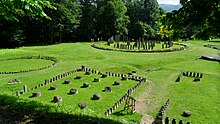
Back Dacia AN داقية Arabic داتشيا ARZ داکیه AZB Дакія Byelorussian Дакия Bulgarian Dakia Breton Dàcia Catalan Dácie Czech Dacia Welsh
Dacian Kingdom | |||||||||||||||
|---|---|---|---|---|---|---|---|---|---|---|---|---|---|---|---|
| c. 82 BC–106 AD | |||||||||||||||
 Approximate extent of Dacia c. 40 BC | |||||||||||||||
| Capital | Argedava Sarmizegetusa | ||||||||||||||
| Common languages | Dacian | ||||||||||||||
| Religion | Thracian polytheism, Zamolxism | ||||||||||||||
| Demonym(s) | Dacian | ||||||||||||||
| Government | Monarchy | ||||||||||||||
| King | |||||||||||||||
• 82-44 BC | Burebista (first) | ||||||||||||||
• 87-106 AD | Decebal (last) | ||||||||||||||
| Historical era | Classical antiquity | ||||||||||||||
• Established | c. 82 BC | ||||||||||||||
| 84–88 AD | |||||||||||||||
| 101–106 AD | |||||||||||||||
• Disestablished | 106 AD | ||||||||||||||
| |||||||||||||||
| This article is part of a series on |
 |
| Dacia |
| Geography |
|---|
| Culture |
| History |
| Roman Dacia |
| Legacy |
Dacia (/ˈdeɪʃə/, DAY-shə; Latin: [ˈd̪aː.ki.a]) was the land inhabited by the Dacians, its core in Transylvania, stretching to the Danube in the south, the Black Sea in the east, and the Tisza in the west. The Carpathian Mountains were located in the middle of Dacia. It thus roughly corresponds to present-day Romania, as well as parts of Moldova, Bulgaria, Serbia, Hungary, Slovakia, and Ukraine.

A Dacian kingdom that united the Dacians and the Getae people existed between 82 BC until the Roman conquest in AD 106, reaching its height under King Burebista. As a result of the two wars with Emperor Trajan, the population was dispersed and the central city, Sarmizegetusa Regia, was destroyed by the Romans, but was rebuilt by them 40 km away to serve as the capital of the Roman province of Dacia. A group of "Free Dacians", may have remained outside the Roman Empire in the territory of modern-day Northern Romania until the start of the Migration Period. The provincial area was conquered by the Romans and incorporated as Roman Dacia, and the area was controlled by the Romans from the conquest in AD 106 to AD 275, over a century of rule.[1]
- ^ "The Original Sarmatians: The Men Who Fought Attila the Hun". Culture.pl. Retrieved 5 January 2024.
© MMXXIII Rich X Search. We shall prevail. All rights reserved. Rich X Search